
The Stone Arch Bridge is a former railroad bridge crossing the Mississippi River at Saint Anthony Falls in downtown Minneapolis, Minnesota. It is the only arched bridge made of stone on the entire Mississippi River. It is the second oldest bridge on the river next to Eads Bridge. The bridge was built to connect the railway system to the new Union Depot, which at that time was planned to be built between Hennepin Avenue and Nicollet Avenue. The bridge was completed in 1883, costing $650,000 at the time. 117 Portland Avenue is the general address of the historic complex.
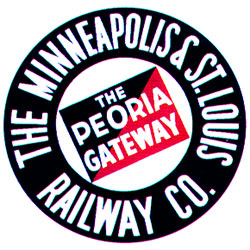
The Minneapolis and St. Louis Railway (M&StL) was an American Class I railroad that built and operated lines radiating south and west from Minneapolis, Minnesota for 90 years from 1870 to 1960. The railway never reached St. Louis but its North Star Limited passenger train ran to that city via the Wabash Railroad.
Chicago, Burlington and Quincy Depot or Chicago, Burlington, and Quincy Station is the name of several railway stations or depots, including:
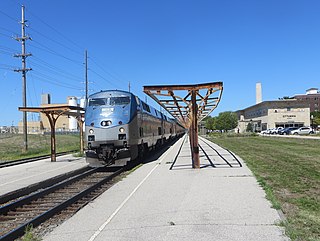
Ottumwa station is an Amtrak intercity train station in Ottumwa, Iowa, United States. The station was originally built by the Chicago, Burlington and Quincy Railroad, and has been listed as Burlington Depot by the National Register of Historic Places since November 26, 2008. It became a contributing property in the Historic Railroad District in 2011.
The Great Northern Depot or Great Northern Passenger Depot may refer to:
Burlington Cedar Rapids and Northern Depot may refer to any railway station on the Burlington, Cedar Rapids and Northern Railway including:
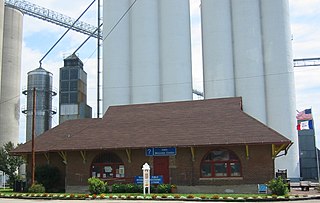
Burlington, Cedar Rapids & Northern Passenger Depot-Dows, also known as the Dows Rock Island Depot, is an historic building located in Dows, Iowa, United States. The depot was built in 1896 and served the Burlington, Cedar Rapids and Northern Railway as a combination passenger and freight station. The Romanesque Revival style was inspired by Henry Hobson Richardson's designs for small railroad stations. It was the first railway depot in Wright County. It passed to the Chicago, Rock Island and Pacific Railroad and continued to serve as a working depot until 1980. The Dows Historical Society bought and restored the depot in 1988. It now serves as a welcome center and railroad museum. It was listed on the National Register of Historic Places in 1993.
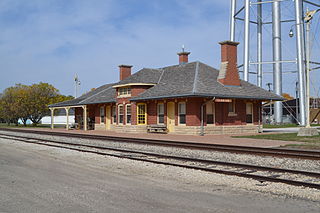
Burlington, Cedar Rapids and Northern Railroad Passenger Station, also known as Rock Island Railroad Depot and the Rock Island Depot Railroad Museum, is a historic building located in Clarion, Iowa, United States. The station was built in 1898 by contractor A. H. Connor & Company of Cedar Rapids, Iowa for the Burlington, Cedar Rapids and Northern Railroad (BCR&N). Clarion also had a Chicago Great Western Railway depot, no longer extant. At one time there were 14 trains that served the city. In 1903 the Chicago, Rock Island and Pacific Railway acquired the BCR&N, and this depot served that railroad. The single story, Romanesque Revival, brick structure measures 26 by 88.5 feet. It was added to the National Register of Historic Places in 1988.

The Rock Island Depot is a historic railroad station located at 201 East 10th Street in Sioux Falls, South Dakota. The station opened in 1886 to serve the Burlington, Cedar Rapids and Northern Railway, a predecessor of the Rock Island. The ashlar and wood building has a Richardsonian Romanesque design with a side-facing stone gable and an octagonal turret. The interior of the station includes a waiting room, a ticket office, and the station agent's quarters. As the railroad network spread through South Dakota, Sioux Falls became the state's primary commercial and transportation hub due to its established station. The station served passenger trains through Sioux Falls until 1970.

The Cascade Bridge is a historic structure located in Burlington, Iowa, United States. In April 1896 the Burlington City Council approved a proposal to have city engineer S.D. Eaton advertise for plans and estimates for a bridge on Main Street that would span Cascade Ravine. The Cascade Lumber Company had petitioned for the bridge. The city contracted with the Cedar Rapids, Iowa firm of Boynton & Warriner to design the structure and the Milwaukee Bridge and Iron Works to erect the span. The city was responsible for building the concrete substructure. The bridge was completed in the fall of 1896, and is composed of four spans. The span length is 160 feet (49 m), and its total length is 464 feet (141 m). The span is a Baltimore deck truss bridge with Pratt deck trusses at both ends. The structure is supported by stone and concrete abutments with concrete pedestals and a single concrete-filled steel cylinder pier. Over the years the original deck has been replaced, and concrete has been applied to the stone abutments. Otherwise the structure has been unaltered. The bridge was listed on the National Register of Historic Places in 1998.

The Burlington, Cedar Rapids & Northern Freight House, also known as the Rock Island Freight House, is a historic building located in Burlington, Iowa, United States. It was listed on the National Register of Historic Places in 1983.
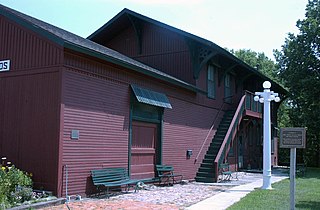
The Burlington, Cedar Rapids, and Northern Railroad-Rock Rapids Station, Railroad Track and Bridge is a nationally recognized historic district located in Rock Rapids, Iowa, United States. It was listed on the National Register of Historic Places in 1976. At the time of its nomination the district included one contributing building and three contributing structures.
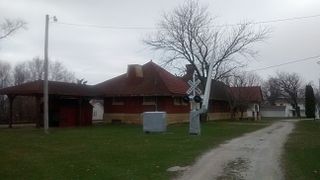
The Burlington, Cedar Rapids & Northern Passenger Station-Vinton, also known as Rock Island Depot and the Vinton Depot, is a historic building located in Vinton, Iowa, United States. Completed in 1900, this depot replaced a previous depot of the Burlington, Cedar Rapids and Northern Railway (BCR&N) located on the east side of town. It was designed by the railroad's architect and chief engineer, H.F. White, and built by A.H. Connor & Company of Cedar Rapids. The single-story brick structure was constructed on a limestone foundation. Three years after it was built, the BCR&N was acquired by the Chicago, Rock Island and Pacific Railroad. It continued to serve as a working depot until 1967. The Benton County Historical Society restored the depot and converted into a railroad museum. The building was listed on the National Register of Historic Places in 1990.

The Hawkeye Street Underpass is a historic structure located south of Nora Springs, Iowa, United States. It spans South Hawkeye Street for 28 feet (8.5 m). The Illinois Central Railroad arrived in Nora Springs in 1868, and the Burlington, Cedar Rapids & Northern Railway (BCR&N) arrived three years later. The later was acquired by the Chicago, Rock Island & Pacific Railroad in the early 1880s. This stone masonry arch underpass was constructed by the Rock Island Line in 1889 as part of an upgrade of the tracks. It was designed by F.A. McDonald who had worked for the BCR&N. It is the only known stone arch bridge in Floyd County. The bridge was listed on the National Register of Historic Places in 1998.

The Mills Tower Historic District is a nationally recognized historic district located in Iowa Falls, Iowa, United States. It was listed on the National Register of Historic Places in 1990. At the time of its nomination the district consisted of six resources, including two contributing buildings, and four non-contributing buildings. All of the buildings are associated with the Illinois Central Railroad (IC). The Dubuque & Sioux City Railroad, an affiliate of the IC, laid the first rail track to Iowa Falls in 1866. The following year the Iowa Falls & Sioux City Railroad, another IC affiliate, continued construction of the line to the west, and it reached Sioux City by 1870. The Burlington, Cedar Rapids and Northern Railway (BCR&N) by way of its affiliate the Cedar Rapids, Iowa Falls & North Western, entered Iowa Falls in 1880. Two years later it was expanded to the north and intersected with the IC main line, which required a controlled crossing. Little is known about this first crossing and what it contained.
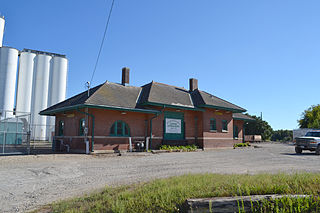
Iowa Falls Union Depot is a historic building located in Iowa Falls, Iowa, United States. The Dubuque & Sioux City Railroad, an affiliate of the Illinois Central Railroad (IC), laid the first rail track to Iowa Falls in 1866. The following year the Iowa Falls & Sioux City Railroad, another IC affiliate, continued construction of the line to the west, and it reached Sioux City by 1870. They built a plain, two-story frame depot to serve Iowa Falls. The Burlington, Cedar Rapids and Northern Railway (BCR&N) by way of its affiliate the Cedar Rapids, Iowa Falls & North Western, entered Iowa Falls in 1880. They built their own depot. It was basically another east–west route, but local business leaders desired a north–south route to serve the community.
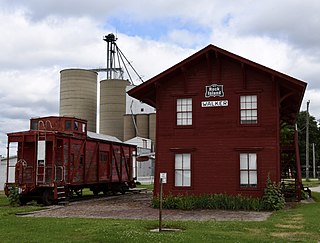
Walker Station is a historic building located in Walker, Iowa, United States. The two-story frame building with bracketed eaves was completed in 1873 along the Burlington, Cedar Rapids, and Minnesota Railway tracks. The depot also served its successor railroads: the Burlington, Cedar Rapids and Northern, and the Chicago, Rock Island and Pacific. Typical of many railroad towns in the Midwest, this is the first building that was built here and the town grew up around it. It is an example of a combination depot that was used for both passenger and freight usage in smaller communities. Because it has a ground level brick platform, service here was primary passenger and light freight service. A higher level of freight service would have required a raised platform.

The Burlington and Northwestern Railway (B&NW) was a 3 ft narrow gauge railroad system in Iowa that operated during the late nineteenth and early twentieth centuries. It connected Burlington, Iowa with branches to Washington and Oskaloosa, Iowa. Incorporated in 1875 as the Burlington and Northwestern Narrow Gauge Railway Company, it began carrying traffic in 1876, when it also dropped 'narrow gauge' from its corporate name. The line reached Washington in 1880, operating over 52.5 miles (84.5 km) of track. In 1881, the Burlington and Western Railway Company, a subsidiary of the Chicago, Burlington and Quincy Railroad (CB&Q) was formed to connect the line to Oskaloosa, completed in 1883. For two decades, both lines were operated as a single system, until on June 20, 1902, the system was widened to standard gauge and the B&NW was adsorbed by the B&W. Later that year, the system was leased to the CB&Q, and in 1903, the entire system was deeded to the CB&Q.



















